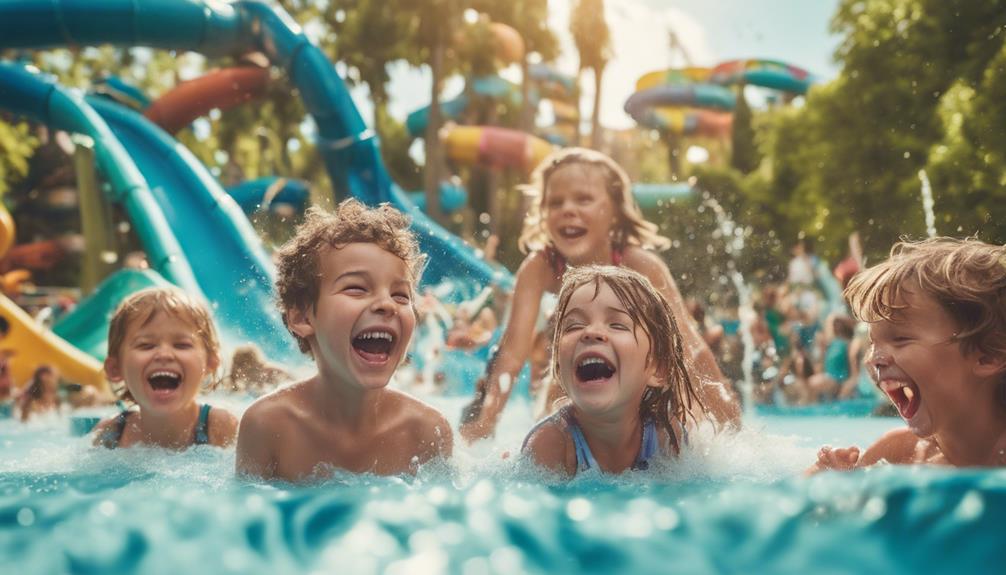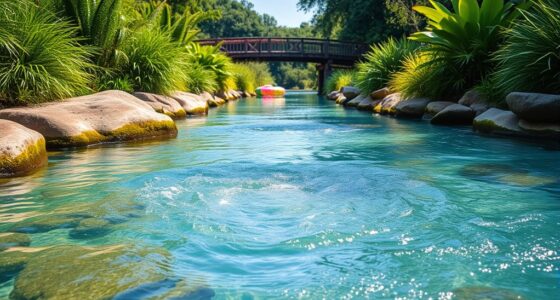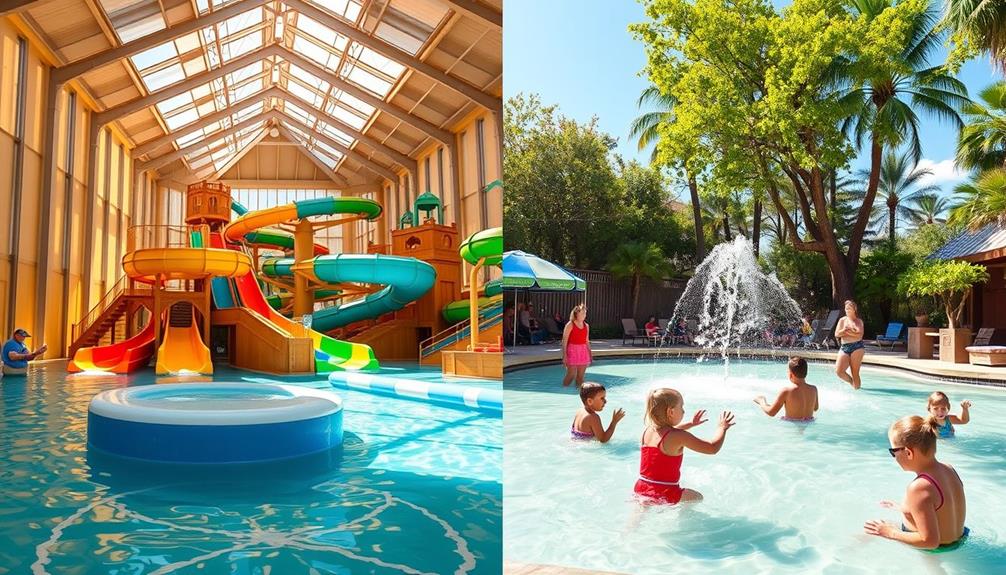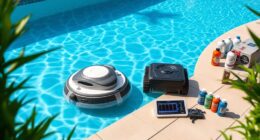To guarantee a fun and secure visit to the water park, it's essential to follow key safety tips. Always supervise children closely, especially non-swimmers, and confirm they wear life vests when needed. Stay sun-safe with generous sunscreen application and protective clothing. Maintain good hygiene by showering before swimming and washing hands regularly. Familiarize yourself with park rules and ride safety guidelines to prevent accidents. Keep hydrated by having water on hand and encouraging breaks. If you keep these tips in mind, you can enhance your experience while promoting safety. There's even more you can discover to make your visit great.
Key Takeaways
- Ensure children under 48 inches wear life vests and are supervised closely by adults at all times.
- Apply broad-spectrum sunscreen 30 minutes before sun exposure and reapply every 80 minutes, especially after swimming.
- Encourage regular hydration; kids should drink water every 20 minutes during activities to prevent dehydration.
- Maintain good hygiene by showering before entering the pool and washing hands after restroom use.
- Familiarize yourself with park rules, ride requirements, and lifeguard instructions to enhance safety and enjoyment.
Child Safety Measures
When it comes to keeping kids safe at the water park, there are several important measures you should take. First, make certain that children under 48 inches in height, non-swimmers, and weak swimmers wear a Coast Guard approved life vest at all times while in the water. This is vital for their safety and gives you peace of mind.
Additionally, many water parks have designated areas for young children, which can provide a safer environment for those who may not be confident in the water yet, making it easier to enjoy the attractions found in best water parks in Washington DC.
Also, if your child is still in diapers, make sure they wear waterproof swim diapers to minimize the risk of leakage into the pool. Direct supervision is essential, especially for young or weak swimmers, so always keep a watchful eye on them while they're enjoying the water.
Establish a designated meeting place in case any child becomes separated from the adults. This way, everyone knows where to regroup if necessary.
Additionally, utilize the buddy system by pairing children together. This guarantees they're not left alone while participating in water activities, making it easier for them to look out for each other.
Sun Protection Strategies

When you head to the water park, protecting your skin from the sun is essential.
Make sure to apply broad-spectrum sunscreen with at least SPF 30 and dress in sun-safe clothing to shield yourself and your kids.
Additionally, consider incorporating a balanced diet rich in whole foods for ideal energy during your visit.
Staying hydrated is equally important, so don't forget to take regular breaks in the shade to keep everyone cool and safe.
Proper Sunscreen Application
Applying sunscreen properly is essential for protecting your skin from harmful UV rays at the water park. Start by choosing a broad-spectrum waterproof sunscreen with an SPF of 30 or higher. Apply approximately two shot glasses worth generously at least 30 minutes before you arrive, ensuring full absorption and protection. Remember to reapply every 80 minutes, especially after swimming, sweating, or towel drying, to maintain effective sun safety procedures.
Here's a quick reference table for your sunscreen application:
| Step | Action | Reminder |
|---|---|---|
| 1. Initial Application | Apply sunscreen at least 30 minutes prior | Use about two shot glasses worth |
| 2. Reapply | Every 80 minutes | After swimming or towel drying |
| 3. Lip Protection | Use a lip balm with SPF 15 or higher | Don't forget your lips! |
Protective Clothing Choices
Choosing the right protective clothing can make a considerable difference in your sun safety at the water park. Start by dressing children in loose, light-colored clothing that reflects sunlight and helps keep them cool. This simple step can reduce the risk of heat-related illnesses, ensuring a more enjoyable day for everyone.
Additionally, consider the benefits of using air purifiers to improve overall air quality during your visit, especially in crowded areas where allergens may be present; air purifiers help alleviate allergy symptoms.
Incorporate hats with brims and UV-protective sunglasses into their outfits. These accessories shield the face and eyes from harmful sun exposure, adding an extra layer of protection.
When it comes to swimwear, opt for fabrics that offer UV protection. This choice considerably reduces direct sunlight on the skin, enhancing overall water safety.
While protective clothing choices are essential, remember they should complement, not replace, sunscreen. Apply broad-spectrum waterproof sunscreen generously on all exposed skin areas, including often-missed spots like ears and feet, at least 30 minutes before entering the water.
Reapply every two hours, or more frequently after swimming or sweating, to maintain effective sun protection throughout the day. By combining protective clothing with diligent sunscreen application, you can enjoy a safe and fun-filled experience at the water park.
Hydration Importance
How can you guarantee your family stays energized and protected while splashing around at the water park? The key lies in understanding hydration importance. Keeping your family well-hydrated helps prevent dehydration and guarantees everyone has a great time, especially during activities that can lead to increased fatigue.
Make sure to drink plenty of water throughout the day, especially during physical activities, as stress management techniques can also alleviate discomfort from overheating. Here are some tips to help you stay on track:
- Encourage kids to drink 5-7 ounces of water every 20 minutes during strenuous activities.
- Avoid sweetened or caffeinated drinks, as they can lead to increased dehydration.
- Set reminders for regular water breaks between rides and swimming sessions.
- Watch for signs of dehydration, like dizziness, fatigue, or dry mouth.
- Keep a water bottle handy to make hydration easy and accessible.
Hygiene Practices

To keep the water park safe and enjoyable, you need to prioritize hygiene practices.
Showering before you jump into the pool is essential for removing dirt and oils, as improper hygiene can lead to increased maintenance needs and potential plumbing issues.
Thorough handwashing after using the restroom helps prevent the spread of germs, especially since flushing only appropriate materials reduces plumbing issues.
Don't forget to rinse off after swimming to maintain cleanliness for yourself and others!
Pre-Swim Hygiene Essentials
Maintaining proper hygiene before diving into the water is essential for ensuring a safe and enjoyable experience at the water park. Adhering to pre-swim hygiene essentials not only promotes your health but also protects others during water-related activities.
Following guidelines similar to those for home cleaning service costs can help you stay informed about the importance of cleanliness. Here are a few key practices you should follow:
- Shower before swimming to remove dirt, sweat, and oils from your body, reducing pool contamination.
- Use designated diaper-changing areas for infants to prevent contamination in the water.
- Encourage children not to swallow pool water, as it can lead to gastrointestinal issues.
- Take your kids to the bathroom frequently throughout the day to minimize accidents and maintain hygiene.
- Wash your hands thoroughly after using the toilet or changing diapers to prevent spreading germs.
Handwashing Importance
After guaranteeing proper hygiene before swimming, it's equally important to focus on handwashing practices to keep everyone safe at the water park. Handwashing is essential, especially after using the restroom and before eating, as it helps prevent the spread of germs and waterborne illnesses in crowded environments.
The CDC recommends washing your hands with soap and water for at least 20 seconds to effectively eliminate harmful pathogens. Additionally, maintaining good hygiene can help reduce the risk of infections, similar to how essential oils possess antibacterial properties which can enhance overall wellness.
You'll find handwashing stations throughout the water park, encouraging regular hygiene practices among guests. Make sure to use them frequently. If you're with children, teach them the importance of handwashing and supervise them to guarantee they clean their hands thoroughly, particularly after using the toilet or changing diapers.
While alcohol-based hand sanitizers can be useful when soap and water aren't available, they shouldn't replace handwashing when your hands are visibly dirty.
Shower After Swimming
Showering after swimming is essential for keeping your skin healthy and free from irritation. Chlorine and other chemicals used in pools can dry out your skin and cause discomfort. By rinsing off with soap and water, you can effectively cleanse your body of these harmful substances.
Plus, showering helps reduce the spread of germs and bacteria that may lurk in communal swimming areas, making your visit more hygienic. Additionally, cat health and nutrition emphasizes the importance of proper hygiene for overall well-being, which can be a valuable lesson for all family members.
Here are some important reasons to shower after swimming:
- Removes chlorine and chemical residues.
- Prevents skin irritation and dryness.
- Reduces the risk of spreading germs.
- Instills good hygiene habits in children.
- Facilities often provide convenient showers nearby.
Don't forget that showering is a simple step to guarantee you stay safe in the water while enjoying your day at the water park.
Encouraging your family to shower after swimming not only promotes better hygiene but also helps everyone feel refreshed and comfortable. So, make it a habit! A quick rinse can go a long way in maintaining your skin's health and enhancing your overall experience at the water park.
Compliance With Park Rules

When you visit a water park, understanding and following the park's rules is essential for your safety and enjoyment. Familiarizing yourself with posted signs and attraction guidelines is important. Always adhere to age, height, and swimming ability restrictions to prevent accidents. Following lifeguard instructions is crucial, as they're trained to maintain safety and respond to emergencies effectively.
Here's a quick reference to help you stay compliant:
| Rule | Importance | Action |
|---|---|---|
| Read posted signs | Guarantees understanding of rules | Take time to review them |
| Follow age/height restrictions | Prevents injuries | Measure yourself or your kids |
| Listen to lifeguards | Essential for safety | Pay attention and follow commands |
| Signal lifeguards for help | Aids in quick response | Raise your hand or shout |
Disease Prevention Guidelines

Understanding the importance of disease prevention at water parks is essential for ensuring a safe and enjoyable experience for everyone. By following some simple guidelines, you can help protect your family and others from potential health risks.
Additionally, being aware of the connections between mental health and cognitive health can contribute to a more enjoyable outing, as stress and anxiety can affect overall well-being mental health support.
- Don't allow children to swim if they're experiencing diarrhea, especially those in diapers.
- Educate kids on proper hygiene practices, like washing their hands after using the toilet and before eating.
- Monitor your children's health throughout your visit for any signs of illness or discomfort.
- Promote awareness of potential health risks, such as skin infections or gastrointestinal illnesses, by encouraging responsible behavior around water.
- Stay updated on CDC recommendations for safe swimming practices to reduce disease transmission risks.
Dress Appropriately for Safety

Ensuring your family is dressed appropriately for a water park outing goes hand in hand with maintaining a safe and healthy environment. Start by dressing your children in hats and loose clothing to minimize sun exposure and prevent heat-related illnesses.
Opt for swimwear made of UV-protective fabrics and light-colored clothing, which helps reflect sunlight and keeps everyone cooler. Engaging in outdoor play can also enhance mood and focus, making it even more enjoyable for your family.
When it comes to footwear, water shoes are a great option for providing better traction and foot protection on wet surfaces. However, keep in mind that water shoes are often not permitted on water slides, so plan accordingly.
If you have little ones who aren't potty trained yet, make sure to use swim diapers to prevent any leakage and maintain pool hygiene.
Lastly, while dressing appropriately is essential, remember to pack a safe drink to keep everyone hydrated during your visit. Staying cool and protected from the sun will allow your family to enjoy the water park experience to the fullest while ensuring their safety.
Hydration and Nutrition Tips

Staying hydrated is vital for a fun and safe day at the water park. You should encourage your kids to drink plenty of water throughout the day, especially after physical activities or spending time in the sun.
Avoid caffeinated beverages and those with artificial sweeteners, as these can lead to dehydration instead of providing proper hydration.
Make certain to schedule regular breaks for meals and snacks to keep everyone's energy levels up. Opt for nutritious options like fruits, vegetables, and whole grains.
Additionally, keep an eye out for signs of dehydration, such as dizziness, fatigue, or dry mouth. It's essential that your children take breaks to hydrate frequently.
Here are some tips to guarantee proper hydration and nutrition:
- Drink water before, during, and after activities.
- Choose healthy snacks to maintain energy.
- Limit sugar and sodas; stick to water.
- Wash hands before meals and snacks to prevent illness.
- Monitor everyone for signs of dehydration.
Supervision Strategies

When you're at the water park, dividing supervision responsibilities among adults can really boost safety.
Keeping toddlers close and maintaining visual contact with older kids is essential as they explore different attractions.
Adult Supervision Responsibilities
In a bustling water park, adult supervision is essential for keeping children safe and secure. You've got an important role in managing adult supervision responsibilities to guarantee everyone enjoys a fun day.
Start by designating specific adults to supervise groups of children, which helps distribute responsibilities effectively.
Here are some strategies to help you monitor how much each child is enjoying their time while staying safe:
- Maintain constant visual contact with toddlers and preschoolers, keeping them within arm's reach.
- Allow older children to explore but establish regular check-ins to guarantee their safety.
- Implement the buddy system, encouraging older kids to stick together and update you on their whereabouts.
- Set a clear, identifiable meeting point in case any child gets separated from the group.
- Regularly communicate safety protocols and emergency procedures, stressing the importance of reporting any concerns.
Visual Contact Importance
Visual contact with children is a key part of effective supervision at a water park. Maintaining this visual connection is vital for ensuring their safety, as it allows you to intervene immediately in case of accidents or emergencies.
For younger children, like toddlers, it's recommended to keep them within arm's reach. This way, you can provide instant assistance if needed, dramatically reducing the risk of drowning.
For preschoolers and school-age children, you should monitor them closely and perform regular visual checks throughout your visit. It's easy for kids to wander, so staying vigilant is essential.
Establishing a buddy system among older children can also be beneficial, encouraging them to look out for one another while still ensuring you maintain visual supervision.
Additionally, setting clear communication methods, such as designated meeting points, helps children know where to go if they become separated from the group.
Emergency Preparedness

Being prepared for emergencies at a water park can make all the difference in ensuring a fun and safe day for everyone. To enhance your emergency preparedness, take a few proactive steps before diving in. Familiarize yourself with the locations of first aid stations and Automated External Defibrillators (AEDs) for quick access if needed. Additionally, review the park’s safety guidelines and ensure you know how to contact staff in case of an urgent situation. Keep an eye out for posted instructions, as these often include valuable water park first aid tips that can help you respond effectively to minor injuries or issues. By staying vigilant and informed, you can focus on enjoying your visit while being ready to handle any unexpected scenarios.
Here are some tips to keep in mind:
- Recognize the signs of heatstroke, especially in young children, and act fast if symptoms appear.
- Establish a clear communication plan with your group, so everyone knows how to signal for help and where to regroup if separated.
- Review the water park's emergency evacuation procedures to know the safest routes and protocols.
- Encourage children to follow safety protocols, like informing an adult if they feel unwell or notice someone in distress.
- Keep a mobile phone handy for emergencies, ensuring it's charged and accessible.
Ride Safety Awareness

Ride safety awareness is crucial for guaranteeing a thrilling yet secure experience at the water park. Before you hop on any ride, take a moment to review the height and weight requirements. These guidelines are in place to keep everyone safe, so don't overlook them. Always pay close attention to ride instructions; improper use can lead to accidents or injuries.
When you're with kids, monitor their reactions closely. Some may feel scared or uncomfortable, so be ready to adjust your plans if needed. Before the ride starts, verify that safety bars and restraints are properly secured. This simple step can greatly reduce the risk of falling or injury.
Additionally, educate your children on ride safety protocols. Remind them to remain seated and keep their arms and legs inside the ride at all times.
If you're heading to a ride that requires extra precaution, make certain to use a Coast Guard approved life vest, especially for younger children or those less confident in the water.
Frequently Asked Questions
What Is One Safety Precaution You Should Take at a Water Park?
One essential safety precaution you should take at a water park is to supervise children closely. Keep them in sight at all times and consider using the buddy system to prevent them from wandering off alone.
How Do You Keep Things Safe at a Waterpark?
You might think safety's just someone else's job, but you can help too. Follow posted rules, stay aware of your surroundings, and respect lifeguards. Your actions contribute greatly to a fun, secure waterpark experience for everyone.
What Should You Keep in Mind While Going to the Water Park?
When you head to the water park, assess your children's swimming skills, pack sunscreen, keep them hydrated, and supervise them closely. Also, familiarize yourself with park rules to guarantee everyone enjoys a safe day.
What Are the Water Safety Tips for Everyone?
You can't just plunge in blindly! Always keep an eye on kids, strap on life jackets, follow rules, and stay hydrated. Teach everyone to walk near pools to dodge those slippery disasters lurking around!
Conclusion
By taking a few simple precautions, you can turn your water park outing into a splashing success! Keep an eye on your little ones, slather on that sunscreen, and stay hydrated while you float through the fun. Remember, a little vigilance goes a long way in keeping everyone safe and sound. So, plunge into the adventure with confidence, knowing you've got the essentials covered for a carefree day of laughter and excitement!










